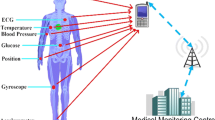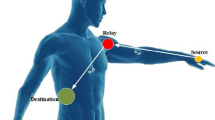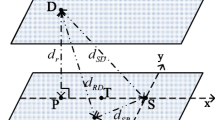Abstract
Body area networks (BAN) are a new variety of wireless sensor networks which are being developed to track patients’ health. The 3.1–10.6 GHz ultra wideband band based BAN design has received huge commendation due to its capacity to provide high data rates and ability to carry medical signals of high bandwidth, on the sombre side however, its range is restricted in the human body channel. It requires novel techniques to improve the reliability and range. This paper proposes a novel approach to this problem. A solution using cooperative relaying has been proposed, that is not only unique, but also superior to classical cooperative relaying techniques. A cooperative relaying scheme employing hybrid relays, capable of a combination of ‘Amplify and Forward’ and ‘Decode and Forward’ relaying is used. In this method the signal to noise ratio, and mean square error, for electrocardiogram, blood pressure, electroencephalograms, and peak signal to noise ratio for magnetic resonance images, retinal and iris images, are measured at the relay and a decision is made to select relaying strategy. The work is unique in the aspect that, simulations have been performed and a comparative performance is presented, which suggests that SNR improvements of at least 3 dB, and quality of received medical signals is vastly enhanced.










Similar content being viewed by others
References
Yuce, M. R. (2010). Implementation of wireless body area networks for healthcare systems. Sensors and Actuators A: Physical, 162(1), 116–129.
Latré, B., Braem, B., Moerman, I., Blondia, C., & Demeester, P. (2010). A survey on wireless body area networks. Wireless Networks, 17(1), 1–18.
Yazdandoost, K. Y., & Sayrafian-Pour, K. (2009). Channel Model for Body Area Network (BAN), IEEE Channel modelling subcommittee report from IEEE P802.15 Working Group for Wireless Personal Area Networks (WPANs).
802.15.6-2012—IEEE Standard for Local and metropolitan area networks: Part 15.6: Wireless Body Area Networks, IEEE, February 2012.
Patel, M., & Wang, J. (2010). Applications, challenges, and prospective in emerging body area networking technologies. IEEE Wireless Communications, 17(1), 80–88.
Liu, K. J. R., Sadek, A. K., Su, W., & Kwasinski, A. (2009). Cooperative communications and networking. New York: Cambridge University Press.
Chen, Y., Teo, J., Lai, J. C. Y., Gunawan, E., Low, K. S., Soh, C. B., & Rapajic, P. B. (2009). Cooperative communications in ultra-wideband wireless body area networks: Channel modeling and system diversity analysis. IEEE Journal on Selected Areas in Communications, 27(1), 5–16.
Boulis, A., Smith, D., Miniutti, D., Libman, L., & Tselishchev, Y. (2012). Challenges in body area networks for healthcare: The MAC. IEEE Communications Magazine, 50(5), 100–106.
Nosratinia, A., Hunter, T. E., & Hedayat, A. (2004). Cooperative communication in wireless networks. IEEE Communications Magazine, 42(10), 74–80.
Guan, Z. J., & Zhou, X. L. (2013). An amplify-and-forward and decode-and-forward mixed relay communication system and its performance analysis. International Journal of Communication Systems,. doi:10.1002/dac.2646.
Laneman, J. N., Tse, D. N. C., & Wornell, G. W. (2004). Cooperative diversity in wireless networks: Efficient protocols and outage behavior. IEEE Transactions on Information Theory, 50(12), 3062–3080.
Arrobo, G. E., & Gitlin, R. D. (2011). New approaches to reliable wireless body area networks. In IEEE international conference on microwaves, communications, antennas and electronics systems (COMCAS). Tel Aviv.
Nazir, M., & Saba, A. (2011). Cooperative cognitive WBAN: From game theory. In Proceedings of the 3rd international congress on ultra modern telecommunications and control systems and workshops (ICUMT). Budapest.
Smith, D. B., & Miniutti, D. (2012). Cooperative body-area-communications: First and second-order statistics with decode-and-forward. In 2012 IEEE wireless communications and networking conference (WCNC). Shanghai.
Khan, I., Rajatheva, N., Tanoli, S. A., & Jan, S. (2013). Performance analysis of cooperative network over Nakagami and Rician fading channels. International Journal of Communication Systems,. doi:10.1002/dac.2500.
Zhang, G., Li, P., Zhou, D., Yang, K., & Ding, E. (2013). Optimal power control for wireless cooperative relay networks: A cooperative game theoretic approach. International Journal of Communication Systems, 26(11), 1395–1408.
Smith, D. B., & Miniutti, D. (2012). Cooperative selection combining in body area networks: Switching rates in gamma fading. IEEE Wireless Communications Letters, 1(4), 284–287.
Ghildiyal, A., Amara, K., Molin, R. D., Godara, B., Amara, A., & Shevgaonkar, R. K. (2010). UWB for in-body medical implants: A viable option. In 2010 IEEE international conference on ultra-wideband (ICUWB2010). Nanjing.
Wang, Q., Masami, K., & Wang, J. (2009). Channel modeling and BER performance for wearable and implant UWB body area links on chest. In IEEE international conference on ultra-wideband, 2009: ICUWB 2009. Vancouver, BC.
Wang, J., & Wang, Q. (2009). Channel modeling and BER performance of an implant UWB body area link. In International symposium on applied sciences in biomedical and communication technologies, 2009: ISABEL 2009 (2nd). Bratislava.
Taparugssanagorn, A., Pomalaza-Raez, C., Isola, A., Tesi, R., Hamalainen, M., & Iinatti, J. (2010). UWB channel modelling for wireless body area networks in a hospital. International Journal of Ultra Wideband Communications and Systems, 1(4), 226–236.
Aoyagi, T., Takada, J.-I., Takizawa, K., Katayama, N., Kobayashi, T., Yazdandoost, K. Y., Li, H.-B., & Kohno, R. (2008). Channel model for wearable and implantable WBANs. In IEEE 802.15-08-0416-04-0006. November 2008.
Sawada, H., Aoyagi, T., Takada, J.-I., Yazdandoost, K. Y., & Kohno, R. (2008). Channel model between body surface and wireless access point for UWB band. In IEEE 802.15-08-0576-00-0006. August 2008.
Oh, J. Y., Kim, J. H., Lee, H. S., & Kim, J. Y. (2010). PSSK modulation scheme for high-data rate implantable medical devices. IEEE Transactions on Information Technology in Biomedicine, 14(3), 634–640.
Askar, N. K., Lin, S. C., Pfister, H. D., Rogerson, G. E., & Furuno, D. S. (2003). Spectral keying™: A novel modulation scheme for UWB systems. In 2003 IEEE conference on ultra wideband systems and technologies. November 2003.
Rout, D. K., Samantaray, L., & Panda, R. (2012). A novel modulation technique for high data rate body area networks. IETE Journal of Research, 58(5), 418.
Siriwongpairat, W. P., & Liu, K. R. (2007). Ultra-wideband communications systems: Multiband OFDM approach. New York: Wiley-IEEE Press.
Ghavami, M., Michael, L. B., & Kohno, A. R. (2007). Ultra wideband signals and systems in communication engineering. New York: Wiley.
Author information
Authors and Affiliations
Corresponding author
Rights and permissions
About this article
Cite this article
Rout, D.K., Das, S. Hybrid Relaying in Ultra-wideband Body Area Networks. Wireless Pers Commun 86, 435–449 (2016). https://doi.org/10.1007/s11277-015-2938-5
Published:
Issue Date:
DOI: https://doi.org/10.1007/s11277-015-2938-5




